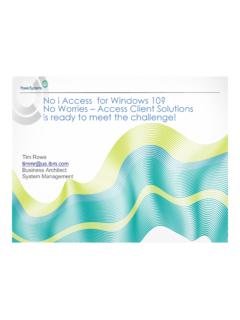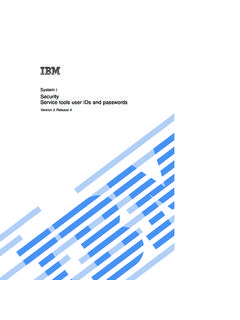Transcription of iSeries SQL Programming: You’ve Got the Power! - …
1 iSeries SQL programming : you ve Got the Power! By Thibault Dambrine On June 6, 1970, Dr. E. F. Codd, an IBM research employee, published "A Relational Model of Data for Large Shared Data Banks," in the Association of Computer Machinery (ACM) journal, Communications of the ACM. This landmark paper still to this day defines the relational database model. The language, Structured English Query Language (known as SEQUEL) was first developed by IBM Corporation, Inc. using Codd's model. SEQUEL later became SQL. Ironically, IBM was not first to bring the first commercial implementation of SQL to market. In 1979, Relational Software, Inc. was, introducing an SQL product named "Oracle".
2 SQL is the ONLY way to access data on Oracle database systems. The ONLY way to access data on Microsoft SQL Server and I could repeat this sentence with a number of other commercial database products. On the iSeries however, SQL is NOT the only way to access the data. SQL support has only started with V1R1. At that time, AS/400 SQL performance was a problem a big turnoff for any developer. Because of these facts, many iSeries developers still consider SQL as an optional skill. Many still use SQL only as an advanced data viewer utility, in effect, ranking SQL somewhere north of DSPPFM. Today, one can barely get by anymore as a programmer without knowing SQL. The same is true for all commercial database systems.
3 They all support SQL. The iSeries is no different. It has evolved to compete. As a programming language, SQL is synonymous with - The ability to do more while coding less than a conventional high-level language like C or RPG - Efficiency while processing large amounts of records in a short period of time - A language offering object-oriented like code recycling opportunities, using SQL Functions and SQL Stored Procedures - Easy to learn and easy to use, SQL is a language that allows one to tell the system what results are required without describing how the data will be extracted This article s first part will describe some common data manipulation methods using SQL.
4 These are from real life applications and they can be applied to a variety of situations. The second part will describe ways to implement SQL code, so that it can be called or evoked by a job scheduler just like any other program on your iSeries . SQL on the iSeries can be implemented in several methods, some of which include using SQL embedded in C, RPG or other languages. In this article however, I will only concentrate only on "pure" SQL, or SQL that is either interpreted (RUNSQLSTM) or compiled into a function or a stored procedure. IBM has packed a lot of power into iSeries SQL. Borrowing Anthony Robbins s words, it is time to "Awaken the Giant Within"! PART 1: CODING IN SQL The Data Unlike most other languages, SQL is not only a language to manipulate data, it is also one that can be used to define the database.
5 In SQL, the category of statements used for this purpose is called Data Definition Language, or DDL. There are many DDL functions, and the point here is not to go through all of them, but I would like to highlight a few that I find most interesting and useful. In DDL: 1) You can define both short (usable in old RPG) and more explicit long fields (usable in SQL). 2) You can define date and time fields with the "DATE" and the "TIMESTAMP" types. This allows date manipulation and date calculations in SQL in a far easier way than in conventional languages. 3) Any table defined in SQL is accessible and mapped by the system like any other file created with DDS. You can do a DSPFD or a DSPFFD with such files just as if they had been created with DDS.
6 Indexes are the same, except they are recognized as Logical Files by the system. Here is an example of this type of definition, with some notes. CREATE TABLE ER100F ( BATCH_ID FOR BTCHID NUMERIC(10) , SOURCE_FACILITY FOR SRCFAL CHAR(50) , LOAD_TIMESTAMP FOR LDTMSP TIMESTAMP ) ; LABEL ON ER100F (SOURCE_FACILITY TEXT IS 'Source Facility ').
7 LABEL ON ER100F (BATCH_ID TEXT IS 'Batch ID '); LABEL ON ER100F (LOAD_TIMESTAMP TEXT IS 'Load Timestamp '); LABEL ON TABLE ER100F IS 'Test Data Fact Table' ; Note the SOURCE_FACILITY column, defined as CHAR, as opposed to VARCHAR (more common is other SQL implementation). This is because on the iSeries , VARCHAR does cause some extra overhead. If you really need to use VARCHAR, you should know that in this type of field, the first two bytes of the field are used to store the length of the field that is occupied with data.
8 For example, if 39 bytes were busy with data out of the 50 bytes available, the number 39 would be in binary in these two bytes. In the past, I also found that using VARCHAR columns for index keys would best be avoided for performance-critical index columns. Note the LOAD_TIMESTAMP column. It is defined as TIMESTAMP. This data type is one of the most valuable in SQL, as one can do data calculations, such as the number of days, hours or minutes between two time stamps. There is also a DATE data type, which is equally useful. Note the "FOR" notation followed by the short field name. This is iSeries -specific and it is there so that the programmer can give a long and a short name to a column.
9 Short here, means 10 characters or less. If you decide to use a long name (greater than 10 characters) for your column without specifying a short name with the FOR operand, the system will create a short name for you. For example: If you chose to use "BATCH_NUMBER" (12 characters in all which is allowable in SQL), SQL will assign a 10-character short name for your column which will look like "BATCH00001" and is typically not very meaningful. One more point on creating tables with SQL: To create a table with a source member written like the one above, you have to use the RUNSQLSTM command. The table will be created in your CURRENT LIBRARY. If you wish to create it elsewhere, you have to first change the CURRENT LIBRARY for the job first.
10 Here is an index example: Indexes are visible on the iSeries as Logicals in a DSPDBR command: CREATE UNIQUE INDEX ER100 FIDX ON ER100F ( BATCH_ID ) On the index, the long or the short names are both valid to specify keys. Note the "UNIQUE" keyword. This is specifying a unique key and is only needed if you do need the key to be unique. With SQL, on the iSeries , in addition to creating a UNIQUE INDEX, one has also the option to create a UNIQUE CONSTRAINT. Constraints, however, do not show up on the DSPDBR command. To find constraints, one has to look in the SQL Catalog.








